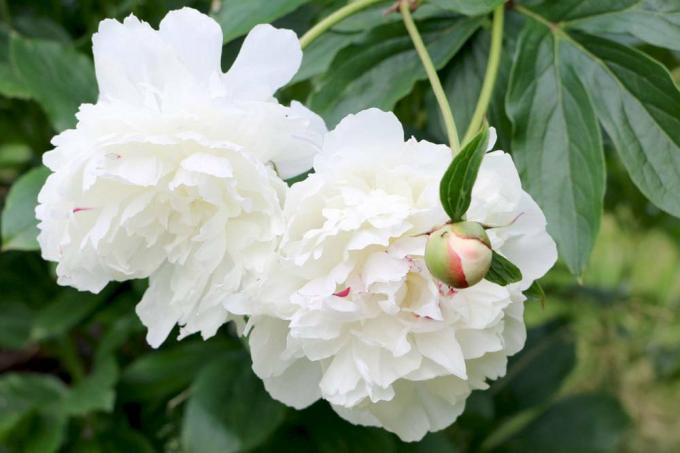
table of contents
- Remove dead peonies
- Summer cut
- Fertilizer application
- Cutting cut flowers
- Seed ripening in autumn
The delicately scented flowers of the Peonies (Peonies) appear in white, pink, and red tones from May to June. Every year these hardy perennials and shrubs bring out lots of flowers again and again and slowly announce summer. Peonies are also popular as cut flowers. Usually these plants are quite easy to care for. However, it should never be neglected to cut off dead flowers immediately after the flowering period. You can find out why this measure is necessary below.
Remove dead peonies
At the end of June / beginning of July, depending on the variety, the beautiful flowers of the peonies are a thing of the past. Then it is time to remove dead peonies. Otherwise, seeds can form very quickly, which is not really desirable, only if it is to be propagated using seeds. More on that later. But why is it important to cut off the withered parts of the plant?
- Prevention of seed formation
- this process takes a lot of strength
- Energy can be used better in roots (rhizomes)
- in summer, plant for blooming takes place next year
- no pruning, then little flowering in the following gardening season
- withered flowers harbor the risk of infection
Faded flowers rot on the shrub in no time. There is then an increased risk of illness. For example, mushrooms find excellent living conditions in withered flowers. Here they are protected and find appropriate moisture for their development.
tip: Fresh flower petals are ideal for making tea, syrup or liqueur.
Summer cut
Wilted flowers should be removed as soon as possible after the flowering period. However, it shouldn't just be so cut loose there are a few things to consider:
- Always cut off withered shoots above a well-developed leaf
- Apply the cut at an angle
- cut part should still have one or two leaves
- Use sharp, clean rose shears
- Do not squeeze the stem of the plant
- cut mainly on dry days
- this prevents germs or dirt from penetrating the interface
- Avoid cutting in bright sunshine
- Otherwise the interface can get burnt
tip: If the dead flowers are not removed regularly, it can easily happen after a few years no bloom more is done.
Fertilizer application
After the faded peonies have been removed, a light fertilizer should be added. Is ideally suited for this
- compost
- Alternatively, organic fertilizers such as horn shavings can also be used
- better still finely ground horn meal, faster decomposition by soil organisms
When the organic fertilizer has been converted into mineral parts by the living things in the soil, it is then completely available to the plants. This supports the new growth and of course the flower formation in the coming spring. The fertilizer should be easily worked into the soil. But be careful, the peony tuber is only a few centimeters below the top layer of soil. The fertilizer must not be raked in too deep to avoid injuries.
Cutting cut flowers
The fragrant peonies are also very popular as Cut flowerswhether individually or in combination with other flowers in the bouquet. If handled correctly, they can be kept in the vase for up to ten days. Incidentally, increased pruning stimulates the flowering for the following year. Proper treatment is necessary so that you can enjoy the peonies in the vase for a long time:
- Cut early in the morning
- Buds should not be too small, but plump and the color of the petals should be recognizable
- Cut off long stem, remove leaves
- Apply the cut at an angle
- Cut cleanly without crushing the stem
- Cut the stems diagonally and place in lukewarm water
- water changes every two to three days
- Then cut the flowers again
- Choose a draft-protected location
tip: The flowers are often attacked by ants. Control is therefore important.
Seed ripening in autumn
If the peonies are to be multiplied by seeds, after the Heyday not all withered flowers are cut off. One or two flowers should then remain. These are perfectly adequate for one sowing. With young plants it is advisable to leave only one withered flower on the bush, otherwise the seed formation of the plant costs too much strength. So-called follicle fruits with seeds contained in them are formed here by autumn. The seed is
- plump, shiny, dark brown to black
- rounded to angular in shape
- ripe when the leaves are reddish in color, usually in late summer
The ripe follicles burst open and the seed emerges. It quickly loses its germination power and should therefore be sown immediately. Storage is recommended until spring at the latest.
sowing
Peonies are cold germs. You need to germinate
- a cold spell lasting several weeks
- this can be done without storage in the refrigerator
- Sow immediately after the harvest in autumn
tip: When propagating by seeds, patience is required. Sometimes it can take two years for germination and even five to ten years for the first bloom.
Sowing should be done in shallow seed trays with loose, sandy soil. To be
- several seeds sown flat
- Bowls placed outdoors
- kept moderately moist
- After germination, pricked out in deep pots in spring
- Sprouts in partially shaded place
- light fertilization in August
- Transplant in place in autumn the following year
The leaves appear first. Mostly it is assumed here that these are cotyledons. However, it is already the right foliage on the plant. The cotyledons are underground.






